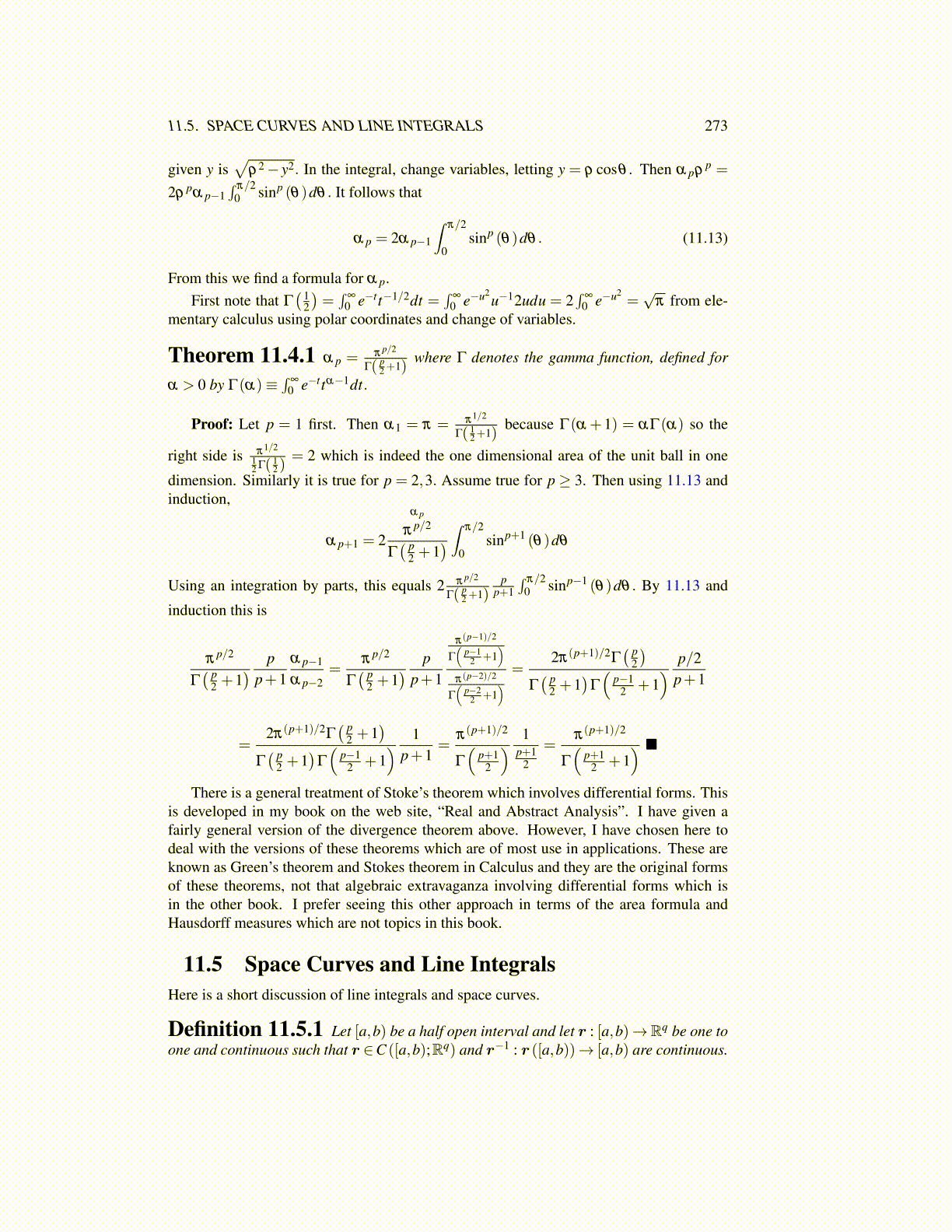
11.5. SPACE CURVES AND LINE INTEGRALS 273
given y is√
ρ2− y2. In the integral, change variables, letting y = ρ cosθ . Then α pρ p =
2ρ pα p−1∫ π/2
0 sinp (θ)dθ . It follows that
α p = 2α p−1
∫π/2
0sinp (θ)dθ . (11.13)
From this we find a formula for α p.First note that Γ
( 12
)=∫
∞
0 e−tt−1/2dt =∫
∞
0 e−u2u−12udu = 2
∫∞
0 e−u2=√
π from ele-mentary calculus using polar coordinates and change of variables.
Theorem 11.4.1 α p = π p/2
Γ( p2 +1)
where Γ denotes the gamma function, defined for
α > 0 by Γ(α)≡∫
∞
0 e−ttα−1dt.
Proof: Let p = 1 first. Then α1 = π = π1/2
Γ( 12+1)
because Γ(α +1) = αΓ(α) so the
right side is π1/212 Γ( 1
2 )= 2 which is indeed the one dimensional area of the unit ball in one
dimension. Similarly it is true for p = 2,3. Assume true for p ≥ 3. Then using 11.13 andinduction,
α p+1 = 2
α p
π p/2
Γ( p
2 +1) ∫ π/2
0sinp+1 (θ)dθ
Using an integration by parts, this equals 2 π p/2
Γ( p2 +1)
pp+1
∫ π/20 sinp−1 (θ)dθ . By 11.13 and
induction this is
π p/2
Γ( p
2 +1) p
p+1α p−1
α p−2=
π p/2
Γ( p
2 +1) p
p+1
π(p−1)/2
Γ
(p−1
2 +1)
π(p−2)/2
Γ
(p−2
2 +1) =
2π(p+1)/2Γ( p
2
)Γ( p
2 +1)
Γ
(p−1
2 +1) p/2
p+1
=2π(p+1)/2Γ
( p2 +1
)Γ( p
2 +1)
Γ
(p−1
2 +1) 1
p+1=
π(p+1)/2
Γ
(p+1
2
) 1p+1
2
=π(p+1)/2
Γ
(p+1
2 +1) ■
There is a general treatment of Stoke’s theorem which involves differential forms. Thisis developed in my book on the web site, “Real and Abstract Analysis”. I have given afairly general version of the divergence theorem above. However, I have chosen here todeal with the versions of these theorems which are of most use in applications. These areknown as Green’s theorem and Stokes theorem in Calculus and they are the original formsof these theorems, not that algebraic extravaganza involving differential forms which isin the other book. I prefer seeing this other approach in terms of the area formula andHausdorff measures which are not topics in this book.
11.5 Space Curves and Line IntegralsHere is a short discussion of line integrals and space curves.
Definition 11.5.1 Let [a,b) be a half open interval and let r : [a,b)→Rq be one toone and continuous such that r ∈C ([a,b);Rq) and r−1 : r ([a,b))→ [a,b) are continuous.